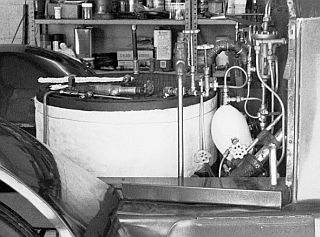|
Original 14” x 23” Boiler Being Piped A 1918 Model 735, 7-passenger Stanley Touring car operates at a nominal 550 PSIG steam pressure. The Stanley fire-tube boiler, located under the hood, generates sufficient steam to operate the car at approximately 35 MPH on level roads. The early Model 735 condensing cars used a 14” high, 23” diameter steel flue boiler. Towards the end of the Model 735 production Stanley had changed to an 18” high boiler to provide more steam storage volume. The car had been last driven in 1992 and it was assumed (incorrectly) that the boiler was fine. An inspection of the boiler revealed it to be in relatively good shape. The layers of piano wire layered around the circumference were in good condition with only surface rust. The flues were clean and only a wire brushing was required to remove the loose carbon and rust. Overall the boiler appeared in good condition so the thought of performing a hydrostatic test were not considered. The boiler would be subjected to a hydrostatic test as part of the hydrostatic testing of all the steam and water piping associated with the boiler. Unfortunately when the time came to hydrostatically test the boiler and its associated piping, problems were uncovered. On July 5, 1998 a hydrostatic test was performed. At 220 PSIG water pressure one of the flues sprang a leak about 1-1/2" down from the top of the boiler. It was a startling experience as a metal cookie tin sitting on the top of the boiler was immediately blown into the air on a strong jet of water. It is standard practice with boilers that when a flue leaks it is plugged at both ends. Only when several have been plugged is the boiler taken out of service and new flues installed. Within a short period of time another flue started leaking. After making several sets of tapered flue plugs, a second attempt at doing a hydrostatic test occurred on July 25, 1998. The water pressure was slowly increased to about 350 PSIG when a third flue started spraying water near the bottom of the boiler. This flue was also plugged and the test started a second time. At about 450 PSIG another tube started leaking about midway along the flue tube. Water was also discovered dripping from a 5th flue leaking near the initial flue that had burst on July 5th and was now plugged. Clearly this boiler was in no condition to generate 600 PSIG steam pressure. It was time to investigate replacing the boiler’s flues or building a new boiler from scratch. There has never been a documented explosion of a Stanley boiler since the tubes are designed to rupture long before the side walls of the boiler ever do. Had this boiler never been hydrostatically tested, the cascade of water from leaking flues as pressure increased would have only served to rain down on the hot, cast burner grate and probably crack it beyond use. |
